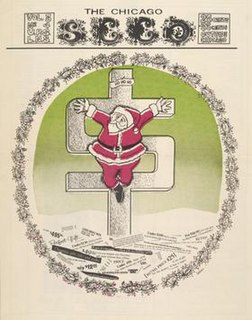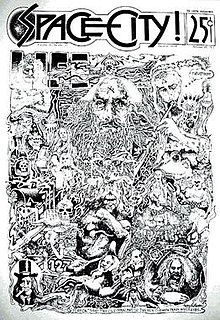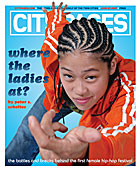
Fifth Estate (FE) is a U.S. periodical, based in Detroit, Michigan, begun in 1965, and presently with staff members across North America who connect via the Internet. Its editorial collective sometimes has divergent views on the topics the magazine addresses but generally shares an anarchist, anti-authoritarian outlook and a non-dogmatic, action-oriented approach to change. The title implies that the periodical is an alternative to the fourth estate.

The terms underground press or clandestine press refer to periodicals and publications that are produced without official approval, illegally or against the wishes of a dominant group. In specific recent Asian, American and Western European context, the term "underground press" has most frequently been employed to refer to the independently published and distributed underground papers associated with the counterculture of the late 1960s and early 1970s in India and Bangladesh in Asia, in the United States and Canada in North America, and the United Kingdom and other western nations. It can also refer to the newspapers produced independently in repressive regimes. In German occupied Europe, for example, a thriving underground press operated, usually in association with the Resistance. Other notable examples include the samizdat and bibuła, which operated in the Soviet Union and Poland respectively, during the Cold War.

The East Village Other was an American underground newspaper in New York City, issued biweekly during the 1960s. It was described by The New York Times as "a New York newspaper so countercultural that it made The Village Voice look like a church circular."

Kaleidoscope was an underground newspaper that was published in Milwaukee, Wisconsin, USA]. Founded by John Kois, the radio disk jockey Bob Reitman and John Sahli, it was published from October 6, 1967, to November 11, 1971, printing 105 biweekly issues. The paper's first issue was printed with a borrowed $250 in an edition of 3,500 copies, which sold out in two days.

The Helix was an American biweekly newspaper founded in 1967 after a series of organizational meetings held at the Free University of Seattle involving a large and eclectic group including Paul Dorpat, Tom Robbins and Lorenzo Milam A member of both the Underground Press Syndicate and the Liberation News Service, it published a total of 125 issues before folding on June 11, 1970.

Seed was an underground newspaper launched by artist Don Lewis and Earl Segal, owner of the Molehole, a local poster shop, and published biweekly in Chicago, Illinois from May 1967 to 1974; there were 121 issues published in all. Disagreements between Lewis and Segal led to its purchase by Harry Dewar, a graphic designer and Colin Pearlson, a photographer, who thought it had commercial potential. Lester Dore took over the art direction when Don Lewis moved to New York to work for Screw magazine. Skeets Millard, a young photographer and community organizer who was publishing the Chicago edition of Kaleidoscope, joined the Seed staff in 1969, at a time when all of the original founders were gone and there was no one working on the paper who had been there more than 12 months; Mike Abrahamson was running the paper in Abe Peck's absence. Jim Roslof, Karl Heinz-Meschbach, Paul Zmiewski, Skip Williamson, Jay Lynch, Peter Solt, and other 60s artists contributed to what was called one of the most beautiful underground press publications of its time.
The Columbus Free Press is an alternative journal published in Columbus, Ohio since 1970. Founded as an underground newspaper centered on anti-war and student activist issues, after the winding down of the Vietnam War it successfully made the transition to the alternative weekly format focusing on lifestyles, alternative culture, and investigative journalism, while continuing to espouse progressive politics. Although published monthly, it has also had quarterly, bi-weekly and weekly schedules at various times in its history, with plans calling for a return to a weekly format by the end of 2014.
Downtown Journal, founded during the 1970s as a print newspaper, was an online and print newspaper serving Minneapolis, Minnesota, in the United States. The paper covered the Minneapolis Mill District, Loring Park, North Loop, Elliot Park and the Mississippi riverfront.

Philadelphia Free Press was a 1960s era underground newspaper published biweekly in Philadelphia, Pennsylvania from 1968 to 1972. Originally launched at Temple University in May 1968 as the monthly Temple Free Press, it separated from Temple and became the Philadelphia Free Press in September 1968.
Max Scherr was an American underground newspaper editor and publisher known for his iconoclastic 1960s weekly, the Berkeley Barb.

The Berkeley Tribe was a radical counterculture weekly underground newspaper published in Berkeley, California from 1969 to 1972. It was formed after a bitter staff dispute with publisher Max Scherr and split the nationally known Berkeley Barb into new competing underground weeklies. In July 1969 some 40 editorial and production staff with the Barb went on strike for three weeks, then started publishing the Berkeley Tribe as a rival paper, after first printing an interim issue called Barb on Strike to discuss the strike issues with the readership. They incorporated as Red Mountain Tribe, named after Gallo's one gallon finger-ringed jug of cheap wine, Red Mountain. It became a leading publication of the New Left.
Sabot was a brief-lived underground newspaper published in Seattle, Washington by the Seattle Liberation Front from September 11, 1970 to January 13, 1971. Sixteen weekly issues were published in all. The paper was started as a replacement for the Seattle Helix which had published its last issue in June 1970. As with its predecessor, Sabot was from the beginning torn by political dissension within the radical political collective, centering on an internal struggle with feminists over issues of male chauvinism and editorial control and direction. After a few months the divided staff was no longer able to get an issue out and the newspaper quit publishing.

Space City! was an underground newspaper published in Houston, Texas from June 5, 1969 to August 3, 1972. The founders were Students for a Democratic Society veterans and former members of the staff of the Austin, Texas, underground newspaper, The Rag, one of the earliest and most influential of the Sixties underground papers. The original editorial collective was composed of Thorne Dreyer, who had been the founding "funnel" of The Rag in 1966; Victoria Smith, a former reporter for the St. Paul Dispatch; community organizers Cam Duncan and Sue Mithun Duncan; and radical journalists Dennis Fitzgerald and Judy Gitlin Fitzgerald.
Pittsburgh Fair Witness was a radical counterculture underground newspaper published in Pittsburgh, Pennsylvania from 1970 to 1973. The first 9 monthly issues were published starting in February 1970 under the title Grok. Beginning with vol. 1, no. 10 the title was changed to Pittsburgh Fair Witness and the paper shifted to publication once every three weeks; starting with the Dec. 3-17, 1971 issue it published on a biweekly schedule until its demise with vol. 4, no. 6. The PFW was staff-owned and published by a collective that called itself "The Commune." An editorial published in the May 26, 1972 issue under the heading "Our Rap" gives the paper's statement of purpose:
"The Fair Witness is published by a non-profit collective and is dedicated to the worldwide movement of people to control themselves—the movement to break down the authoritarian systems of government that are denying us our basic freedoms, that are responsible for needless genocidal wars, the perpetration of minority discrimination, the pollution of our environment and our bodies, the high concentration of power among the wealthy classes, exploitation of the individual, etc. The paper is dedicated to the struggle of all peoples to gain back the right to their own lives, the struggle to raise the consciousness of the world as a whole, the struggle to become independently productive through a working knowledge of the tools at our disposal. As a local paper our most important function concerns the movement here in western Pennsylvania."
The Big Us was a radical underground newspaper published in Cleveland, Ohio starting in September, 1968, appearing biweekly in tabloid format. Its politics reflected the views of SDS. Editors were Carol Cohen McEldowney, a 25-year-old SDS organizer and Cleveland welfare caseworker, and Carole Close, an antiwar activist. The paper's headquarters were in a church coffeehouse/youth center called The Outpost, near the Case Western Reserve University campus. McEldowney left in May 1969 to work in an antiwar GI coffeehouse in South Carolina, and starting with the issue of Oct. 14, 1969 the paper changed its name to Burning River News, commemorating a famous incident in which the toxic waste on the surface of the Cuyahoga River in downtown Cleveland caught fire.

Old Mole was a radical New Left oriented underground newspaper published in Cambridge, Massachusetts from September 1968 to September 1970. Old Mole was continued by a second volume titled The Mole, which published five issues from November 1970 to April 1971. Printed biweekly in a 16-page tabloid format, Old Mole was based for most of its existence in a storefront and basement office on Brookline Street in Central Square. Selling for 15 cents, 47 issues were published in all, with press runs averaging 8000 to 10,000 copies. Subscriptions were free to prisoners and soldiers.
The Eugene Augur was a local countercultural underground newspaper published in Eugene, Oregon, United States, from 1969 to 1974. Starting with its first issue dated October 14, 1969, the Augur, produced by a cooperative of left-wing political activists aligned with the antiwar movement, appeared twice a month, offering up a mix of New Left politics and acid rock counterculture to an audience of students, hippies, radicals and disaffected working class youth in the Eugene area. The paper's coverage ranged from antiwar demonstrations, exposing local narcotics agents, and rock festivals, to the growth of backwoods communes in Southern Oregon and the annual Oregon Renaissance Faire. In August 1972, the paper cut publication to a monthly schedule. Staffers included Peter Jensen and Jim Redden, son of a prominent Oregon politician and later a reporter for the Portland Tribune.

City Pages was an alternative newspaper serving the Minneapolis–St. Paul metropolitan area. It featured news, film, theatre and restaurant reviews and music criticism, available free every Wednesday. It ceased publication in 2020 due to a decline in ads and revenue related to the COVID-19 pandemic.












